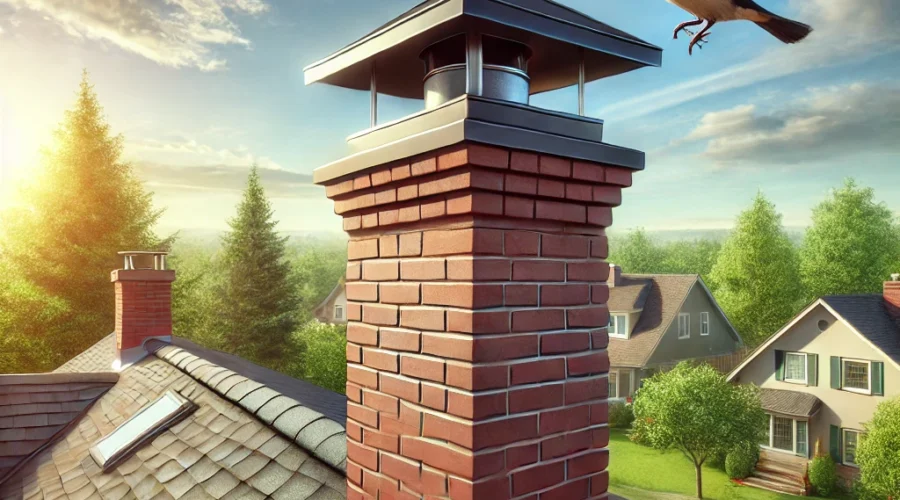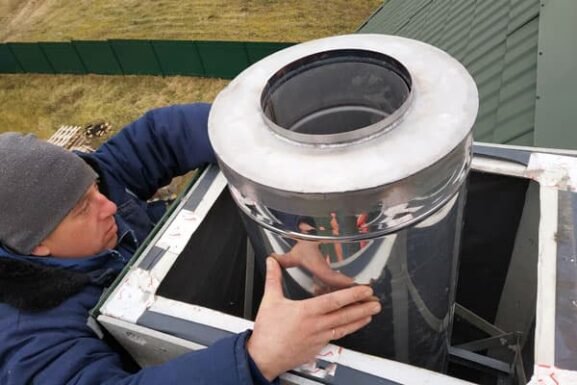Preventing Birds Entering Chimneys Through Damaged Caps: Effective Solutions & Tips
We’ve all heard the gentle cooing of birds, but imagine that sound echoing from your chimney. Birds entering chimneys through damaged caps is more common than you might think. These feathery visitors can quickly turn from delightful to disruptive, causing noise, debris, and even potential hazards for homeowners.
Damaged chimney caps provide an open invitation for birds seeking shelter or nesting spots. This not only disrupts their natural habitat but also poses risks to our homes, like blockages and fire hazards. Understanding why birds are drawn to these spaces and how to prevent their entry is crucial for maintaining a safe and bird-free chimney.
In this text, we’ll explore the reasons birds find chimneys so appealing, the problems they can cause, and effective solutions to keep them out. Let’s jump into how we can protect our chimneys and ensure our homes remain cozy and bird-free.
Chimney Caps and Bird Intrusions: What Homeowners Need to Know
Birds see chimneys as cozy spots for nesting. Who can blame them? These warm and sheltered spaces are a bird’s dream. Unfortunately, damaged caps turn chimneys into open invitations for our feathered friends. Damaged caps can result in numerous issues like nesting problems and unwanted chimney wildlife intrusions. Let’s explore what we can do to keep our chimneys bird-free.
Prevention Measures
- Chimney Protection: Bird-proofing chimneys requires sturdy caps. They act as shields, preventing birds from entering and causing chaos.
- Cap Maintenance: Regular inspections ensure caps stay functional. We must replace or repair any damage promptly.
- Pest Control: Professional services secure our homes from uninvited guests. Remember, a cap can’t sing like a bird but can keep them out!
Chimney Safety Tips
Safety first! A blocked chimney can lead to fire risks. The National Fire Protection Association and Chimney Safety Institute of America emphasize the importance of clear pathways. Regular cleaning keeps our homes safe and sound.
Causes Of Damaged Chimney Caps
Birds exploring chimneys like it’s an open house often encounter damaged caps. Let’s see what gets their attention and how these caps end up in ruins.
Weather Impact
Weather can be a relentless opponent for chimney caps. The constant freeze-thaw cycles and storms can warp, crack, or break the caps, providing an open invitation to feathered guests.
- Winter’s Wrath: Ice forms in cracks, expanding them further each freeze.
- Summer Sun: Heat can warp metal caps, causing misalignment and gaps.
- Stormy Gusts: Winds can bend or remove caps, undoing their bird-proofing efforts.
If a cap looks like it’s been in a wrestling match with Mother Nature, it’s time to call professionals for repair or replacement.
Poor Maintenance
Regular upkeep is crucial for chimney cap durability. Many homeowners overlook this until it’s too late.
- Neglected Caps: Dirt and grime hide damage until birds set up a live soundtrack in your flue.
- Rust Ravages: Moisture from rain and snow corrodes metal caps.
- Structural Wear: Regular inspections can catch cracks or shifted caps before they cause nesting problems.
Ignoring cap maintenance can lead to increased wildlife ingress and, eventually, costly repairs. Remember, reach out to professionals for consultation.
How Birds Enter Chimneys

Damaged caps create a starring role in bird entry dramas by turning chimneys into cozy nesting spots. Our feathered friends may see these spots as their dream condo without a lease agreement.
Typical Bird Species
Several bird species consider chimneys their ideal home sweet home. Birds like chimney swifts, starlings, and sparrows lead this unwelcome list. Each species brings its own set of nesting problems. Chimney swifts, for example, prefer to stick around in cozy chimneys during migration. Starlings, known for their adaptability, make nests swiftly. Sparrows also display a knack for squeezing through any slight crack. Understanding these bird behaviors helps us carry out effective prevention measures. We aim to bird-proof chimneys and ensure safety.
Seasonal Patterns
Seasons play a big role in bird activity. During spring, these critters welcome nesting season like clockwork. Chimneys become prime real estate as birds search for sheltered spots. Summer sees them raise their young, making themselves quite at home. In fall, though migrations offer hope, some may linger in damaged caps. Winter snuggles bring few birds but don’t let your guard down. Regular inspection and cap maintenance prove essential year-round in some areas.
To bird-proof chimneys and secure homes from unwanted wildlife, reach out to professionals for consultation. Let’s keep your chimneys bird-free and your home safe without squawk and squabble.
Consequences Of Birds In Chimneys
Birds entering chimneys through damaged caps isn’t a minor inconvenience. It poses significant risks ranging from health issues to structural damage.
Health Risks
Bird entry into chimneys can bring several health concerns. Bird droppings harbor pathogens like Histoplasmosis and Psittacosis, which are dangerous when inhaled. Also, nesting materials block airways, causing smoke to back up inside. This increases carbon monoxide levels, a colorless gas that can be fatal if inhaled in large amounts. According to the Chimney Safety Institute of America, maintaining clear flues is crucial for preventing such hazards. Regular cap maintenance and bird-proofing chimneys help keep these issues at bay. Reach out to professionals for consultation, and ensure your chimney safety.
Structural Damage
Birds cause structural damage by building nests that block airflow, leading to moisture buildup inside chimneys. This can damage chimney linings and surrounding masonry. Over time, water can seep into bricks and mortar, causing serious damage and costly repairs. Birds like starlings and chimney swifts add to this problem with nests that can weigh down and crack caps further, worsening the damage. Prevention measures such as installing durable chimney caps and scheduling regular inspections are essential to protect your home. The National Fire Protection Association advises homeowners to be vigilant about chimney maintenance to avoid structural issues. Contact us for expert advice on chimney protection and bird-proofing chimneys.
Preventing Bird Entry
Birds love chimneys like kids love candy. To keep them out and protect your home, it’s vital to focus on prevention strategies.
Regular Inspection
Regular checks are key to keeping chimneys bird-free. This lets us spot damaged caps early. For many homeowners, ignoring maintenance spells trouble.
- Seasonal Checks: Especially in icy winters and humid summers, routine inspections prevent nesting problems.
- Professional Services: Experts catch small issues before they grow. Remember, a tiny crack can be a bird’s welcome mat.
- Quick Repairs: Fixing a little crack stops bigger problems. Let’s keep those birds using trees, not chimneys.
Curious about your chimney’s condition? Reach out to professionals for consultation and ensure it’s in tip-top shape.
Quality Cap Installation
Installing quality caps is half the battle in bird-proofing chimneys. Birds can’t nest if they can’t get in.
- Durable Materials: We use sturdy materials that withstand the weather. Metal or heavy-duty plastic caps are best.
- Secure Installation: Loose installations risk bird entry. Our experts ensure caps fit perfectly and stay put.
- Chimney Safety Tips: A good cap is a fortress against wildlife. It’s not just about keeping birds out; it’s about protecting you and your family from pests and chimney wildlife like raccoons.
Think your chimney cap needs an upgrade? Reach out to professionals for consultation.

Protecting Your Home: Preventing Bird Entry with Durable Chimney Caps
We’ve explored the myriad challenges posed by birds entering chimneys through damaged caps and the significant risks they bring. It’s clear that prevention is key to maintaining a safe home environment. By investing in durable chimney caps and committing to regular inspections, we can effectively keep birds at bay and protect our homes from potential hazards. Let’s ensure our chimneys remain secure and functional all year round. For those seeking expert guidance, scheduling a consultation with professionals can provide peace of mind and ensure our chimneys are in top condition.
Frequently Asked Questions
Why do birds enter chimneys?
Birds enter chimneys because they see them as safe, sheltered places to build nests. Damaged or missing chimney caps create easy entry points for birds, which are attracted to the warmth and protection chimneys offer. This behavior is common among species like chimney swifts and starlings, especially during the nesting season in spring. Regular maintenance and secure chimney cap installation can help prevent bird entry.
What are the risks of having birds in your chimney?
Birds in chimneys pose several risks, including noise disturbances, debris accumulation, and serious hazards like blockages and fire risks. Nests can obstruct airflow, potentially causing dangerous carbon monoxide buildup. Moreover, bird droppings carry harmful pathogens, and nesting materials can damage chimney linings and masonry over time, leading to costly repairs.
How can I prevent birds from entering my chimney?
Prevent birds from entering your chimney by installing a sturdy, well-fitted chimney cap and scheduling regular inspections. Maintaining the cap’s condition and addressing any wear or damage quickly can deter bird entry. Additionally, using professional pest control services can help manage and prevent wildlife intrusion, keeping your home safe.
What causes chimney caps to become damaged?
Chimney caps can become damaged due to weather conditions and poor maintenance. Harsh winters can lead to ice expansion and cracks, while humid summers can warp or rust metal caps. Stormy winds may also harm caps. Neglecting maintenance allows dirt buildup, rust from moisture, and structural wear, increasing wildlife ingress risks.
What bird species commonly nest in chimneys?
Chimney swifts, starlings, and sparrows are common bird species that nest in chimneys. Each species presents unique challenges due to their nesting habits and seasonal patterns. For instance, spring marks the start of their nesting season, making it crucial for homeowners to conduct year-round inspections and maintenance to prevent bird entry.
Are there health risks associated with birds in chimneys?
Yes, there are health risks associated with birds in chimneys. Bird droppings can contain harmful pathogens that pose health risks. Nesting materials may block chimneys, increasing carbon monoxide levels indoors. Additionally, nests can cause moisture buildup, damaging chimney linings, which can compromise structural integrity and lead to further hazards.
How often should chimney caps be inspected?
Chimney caps should be inspected at least once a year. Regular inspections help identify and address minor damages early, preventing them from becoming major issues. This is particularly important in areas with harsh weather conditions, where seasonal weather can quickly deteriorate caps, facilitating wildlife entry and potential hazards.


